Ditylenchus destructor(DITYDE)
Photos
For publication in journals, books or magazines, permission should be obtained from the original photographers with a copy to EPPO.
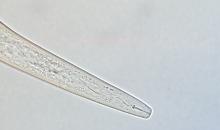
Stylet
Courtesy: Niloufar Mahmoudi. Yousef Naserzadeh.Elena Pakina. Liudmila Limantceva. Department of Agro-Biotechnology, Institute of Agriculture, RUDN University. All-Russian Plant Quarantine Centre (VNIIKR), Moscow, Russia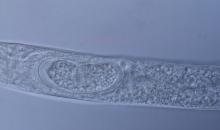
Egg
Courtesy: Niloufar Mahmoudi. Yousef Naserzadeh.Elena Pakina. Liudmila Limantceva. Department of Agro-Biotechnology, Institute of Agriculture, RUDN University. All-Russian Plant Quarantine Centre (VNIIKR), Moscow, Russia
Cloacal region
Courtesy: Niloufar Mahmoudi. Yousef Naserzadeh.Elena Pakina. Liudmila Limantceva. Department of Agro-Biotechnology, Institute of Agriculture, RUDN University. All-Russian Plant Quarantine Centre (VNIIKR), Moscow, Russia
Female anterior region
Courtesy: Niloufar Mahmoudi. Yousef Naserzadeh. Department of Agro-Biotechnology, Institute of Agriculture, RUDN University. All-Russian Plant Quarantine Centre (VNIIKR), Moscow, Russia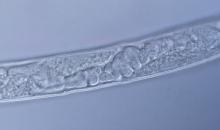
Crustaformeria
Courtesy: Niloufar Mahmoudi. Yousef Naserzadeh.Elena Pakina. Liudmila Limantceva. Department of Agro-Biotechnology, Institute of Agriculture, RUDN University. All-Russian Plant Quarantine Centre (VNIIKR), Moscow, Russia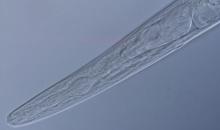
Oesophagous
Courtesy: Niloufar Mahmoudi. Yousef Naserzadeh. Department of Agro-Biotechnology, Institute of Agriculture, RUDN University. All-Russian Plant Quarantine Centre (VNIIKR), Moscow, Russia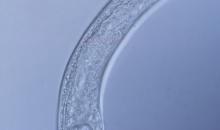
Post-vuval uterine sac (PUS)
Courtesy: Niloufar Mahmoudi. Yousef Naserzadeh. Department of Agro-Biotechnology, Institute of Agriculture, RUDN University. All-Russian Plant Quarantine Centre (VNIIKR), Moscow, Russia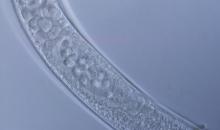
Spermatheca
Courtesy: Niloufar Mahmoudi. Yousef Naserzadeh. Department of Agro-Biotechnology, Institute of Agriculture, RUDN University. All-Russian Plant Quarantine Centre (VNIIKR), Moscow, Russia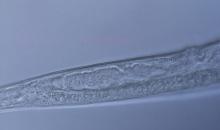
Vulva to anus distance
Courtesy: Niloufar Mahmoudi. Yousef Naserzadeh. Department of Agro-Biotechnology, Institute of Agriculture, RUDN University. All-Russian Plant Quarantine Centre (VNIIKR), Moscow, Russia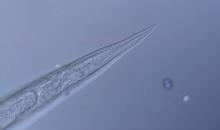
Female tail
Courtesy: Niloufar Mahmoudi. Yousef Naserzadeh. Department of Agro-Biotechnology, Institute of Agriculture, RUDN University. All-Russian Plant Quarantine Centre (VNIIKR), Moscow, Russia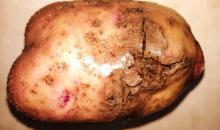
Advanced symptoms of damage by the stem nematode on a potato tuber and symptoms of the common scab, Streptomyces scabiei, as well; Moscow region, Russia; 2021
Courtesy: Maria A. Kuznetsova (All-Russian Research Institute of Phytopathology)
Severe symptoms on heavily infested potatoes, by the stem nematode, Ditylenchus destructor (tuber shrinking , tissue below the tuber skin darkens and the tissue forms spongy in texture with lumpy masses) and then secondary invasions of bacteria and Fusarium spp. occur; Moscow region, Russia; 2021
Courtesy: Maria A. Kuznetsova (All-Russian Research Institute of Phytopathology)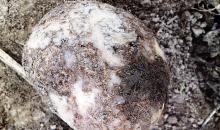
Heavily infested potato tuber; advanced symptoms; Moscow region, Russia; 2021
Courtesy: Maria A. Kuznetsova (All-Russian Research Institute of Phytopathology)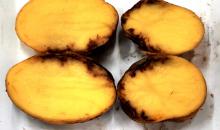
Symptoms of early damage by the stem nematode on cut tubers. The pest invades potatoes and then there are some small spots of tissue below the potato skin, that have a puffy texture; Moscow region, Russia; 2021
Courtesy: Maria A. Kuznetsova (All-Russian Research Institute of Phytopathology)
Adult specimen and juvenile of Ditylenchus destructor
Courtesy: Maria A. Kuznetsova (All-Russian Phytopathology Research Institute)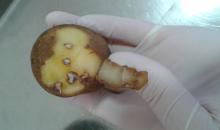
Symptoms of damage to potato tubers (in section of the tuber) Ditylenchus destructor. Ukraine.
Courtesy: Khomenko Iryna Olehivna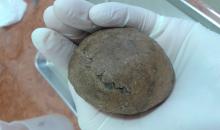
External signs of Ditylenchus destructor damage to potato tubers. Ukraine.
Courtesy: Khomenko Iryna Olehivna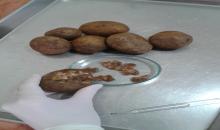
External signs of damage on a section of a potato tuber, with severe damage by Ditylenchus destructor. Ukraine.
Courtesy: Khomenko Iryna Olehivna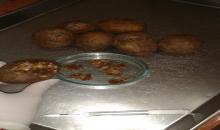
External signs of damage on a section of a potato tuber, with severe damage by Ditylenchus destructor. Ukraine.
Courtesy: Khomenko Iryna Olehivna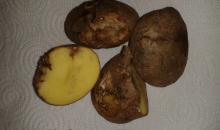
External signs of Ditylenchus destructor damage to potato tubers. Ukraine.
Courtesy: Khomenko Iryna Olehivna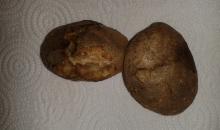
External signs of Ditylenchus destructor damage to potato tubers. Ukraine.
Courtesy: Khomenko Iryna Olehivna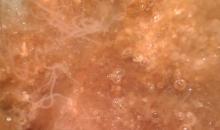
Ditylenchus destructor Thorne on potato peel during extraction. Ukraine.
Courtesy: Khomenko Iryna Olehivna
External symptoms, showing sunken areas with cracked and wrinkled skin.
Courtesy: Central Science Laboratory, York (GB) - British Crown.




